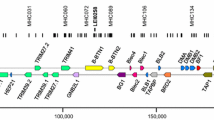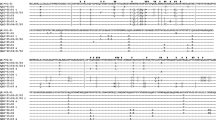Abstract
Minor histocompatibility antigens (MiHAs) stimulate the rejection of allografts when donors and recipients are matched at the major histocompatibility complex (MHC). The majority of identified autosomal MiHAs were generated by non-synonymous (NS) substitutions that alter MHC class I-binding peptides. The mosaic distribution of single nucleotide polymorphisms (SNPs) that distinguish inbred mouse strains led us to hypothesize that MiHA genes defined by congenic strains on C57BL/6 and C57BL/10 backgrounds map to chromosomal regions with relatively high numbers of NS SNPs that distinguish C57 strains from other common inbred strains. To test this hypothesis, we mapped the ends of differential chromosome segments of congenic strains, which define 12 MiHAs, relative to microsatellites and SNPs. The lengths of differential segments ranged from 9.7 to 105.9 Mbp in congenic strains where no attempts were made to select recombinants within these segments. There was no apparent correlation between differential segment length and number of backcrosses, suggesting that factors other than the number of opportunities for recombination affected the differential segment lengths in these congenics. These differential segments included higher numbers of NS SNPs that distinguish C57BL/6J from A/J, DBA/2J, and 129S1/J than would be predicted if these SNPs were uniformly distributed along the chromosomes. The most extreme case was the H8 congenic that included 74% of the SNPs on chromosome 14 within its 9.7–11.1 Mbp differential segment. These results point toward a direct relationship between the level of genomic divergence, as indicated by numbers of NS SNPs, and numbers of MiHAs that collectively determine the magnitude of allograft rejection.






Similar content being viewed by others
References
Bailey DW (1970) Four approaches to estimating number of histocompatibility loci. Transplant Proc 2:32–38
Bailey DW (1971) Recombinant-inbred strains. An aid to finding identity, linkage, and function of histocompatibility and other genes. Transplantation 11:325–327
Bailey DW (1973) Inbred strains of mice. Mouse Newsletter 49:27–31
Bailey DW (1975) Genetics of histocompatibility in mice. I. New loci and congenic lines. Immunogenetics 2:249–256
Bailey DW, Mobraaten LE (1969) Estimates of the number of loci contributing to the histocompatibility between C57BL/6 and BALB/c strains of mice. Transplantation 7:394–400
Berman JW, Rocha AJ, Basch R (1986) Restriction length polymorphism in the variable region of the Tcr locus linked to histocompatibility antigen H-8 on murine chromosome 14. Immunogenetics 24:328–330
Davis AP, Roopenian DC (1990) Complexity at the mouse minor histocompatibility locus H-4. Immunogenetics 31:7–12
Gabriel SB, Schaffner SF, Nguyen H, Moore JM, Roy J, Blumenstiel B, Higgins J, DeFelice M, Lochner A, Faggart M, Liu-Cordero SN, Rotimi C, Adeyemo A, Cooper R, Ward R, Lander ES, Daly MJ, Altshuler D (2002) The structure of haplotype blocks in the human genome. Science 296:2225–2229
Graber JH, Churchill GA, Dipetrillo KJ, King BL, Petkov PM, Paigen K (2006) Patterns and mechanisms of genome organization in the mouse. J Exp Zool 305A:683–688
Graff RJ, Snell GD (1968) Histocompatibility genes of mice. 8. The alleles of the H-1 locus. Transplantation 6:598–617
Jeffreys AJ, Kauppi L, Neumann R (2001) Intensely punctate meiotic recombination in the class II region of the major histocompatibility complex. Nat Genet 29:217–222
Luedtke B, Pooler LM, Choi EY, Tranchita AM, Reinbold CJA, Brown AC, Shaffer DJ, Roopenian DC, Malarkannan S (2003) A single nucleotide polymorphism in the Emp3 gene defines the H4 minor histocompatibility antigen. Immunogenetics 55:284–295
Malarkannan S, Shih PP, Eden PA, Horng T, Zuberi A, Christianson G, Roopenian D, Shastri N (1998) The molecular and functional characterization of a dominant minor H antigen, H60. J Immunol 161:3501–3509
Malarkannan S, Horng T, Eden P, Gonzalez F, Shih P, Brouwenstijn N, Klinge H, Christianson G, Roopenian D, Shastri N (2000) Differences that matter: major cytotoxic T cell-stimulating minor histocompatibility antigens. Immunity 13:333–344
Matise TC, Sachidanandam R, Clark AG, Kruglyak L, Wijsman E, Kakol J, Buyske S, Chui B, Cohen P, de Toma C, Ehm M, Glanowski S, He C, Heil J, Markianos K, McMullen I, Pericak-Vance MA, Silbergleit A, Stein L, Wagner M, Wilson AF, Winick JD, Winn-Deen ES, Yamashiro CT, Cann HM, Lai E, Holden AL (2003) A 3.9-centimorgan-resolution human single-nucleotide polymorphism linkage map and screening set. Am J Hum Genet 73:271–284
McBride K, Baron C, Picard S, Martin S, Boismenu D, Bell A, Bergeron J, Perreault C (2002) The model B6dom1 minor histocompatibility antigen is encoded by a mouse homolog of the yeast STT3 gene. Immunogenetics 54:562–569
Mendoza LM, Paz P, Zuberi A, Christianson G, Roopenian D, Shastri N (1997) Minors held by majors: the H13 minor histocompatibility locus defined as a peptide/MHC class I complex. Immunity 7:461–472
Mendoza L, Villaflor G, Eden P, Roopenian D, Shastri N (2001) Distinguishing self from nonself: immunogenicity of the murine H47 locus is determined by a single amino acid substitution in an unusual peptide. J Immunol 166:4438–4445
Muller-Sieburg CE, Riblet R (1996) Genetic control of the frequency of hematopoietic stem cells in mice: mapping of a candidate locus to chromosome 1. J Exp Med 183:1141–1150
Nishant KT, Ravishankar H, Rao MRS (2004) Characterization of a mouse recombination hot spot locus encoding a novel non-protein-coding RNA. Mol Cell Biol 24:5620–5634
Nishant KT, Kumar C, Rao MRS (2006) HUMHOT: a database of human meiotic recombination hot spots. Nucleic Acids Res 34:D25–D28
Paigen B, Mitchell D, Reue K, Morrow A, Lusis AJ, LeBoeuf RC (1987) Ath-1, a gene determining atherosclerosis susceptibility and high density lipoprotein levels in mice. Proc Natl Acad Sci USA 84:3763–3767
Patil N, Berno AJ, Hinds DA, Barrett WA, Doshi JM, Hacker CR, Kautzer CR, Lee DH, Marjoribanks C, McDonough DP, Nguyen BTN, Norris MC, Sheehan JB, Shen N, Stern D, Stokowski RP, Thomas DJ, Trulson MO, Vyas KR, Frazer KA, Fodor SPA, Cox DR (2001) Blocks of limited haplotype diversity revealed by high-resolution scanning of human chromosome 21. Science 294:1719–1723
Petkov PM, Graber JH, Churchill GA, Dipetrillo KJ, King BL, Paigen K (2005) Evidence of a large-scale functional organization of mammalian chromosomes. PLoS Genet 1:312–322
Petkov PM, Ding Y, Cassell MA, Zhang W, Wagner G, Sargent EE, Asquith S, Crew V, Johnson KA, Robinson P, Scott VE, Wiles MV (2006) An efficient SNP system for mouse genome scanning and elucidating strain relationships. Genome Res 14:1806–1811
Rotzschke O, Falk K, Wallny HJ, Faath S, Rammensee HG (1990) Characterization of naturally occurring minor histocompatibility peptides including H-4 and H-Y. Science 249:283–287
Sahara H, Shastri N (2003) Second class minors: molecular identification of the autosomal H46 histocompatibility locus as a peptide presented by major histocompatibility complex class II molecules. J Exp Med 197:375–385
Snell GD (1948) Methods for the study of histocompatibility genes. J Genet 49:87–108
Snell GD, Bunker HP (1964) Histocompatibility genes of mice. IV. The position of H-3 in the fifth linkage group. Transplantation 2:743–751
Snell GD, Stevens LC (1961) Histocompatibility genes of mice. III. H-1 and H-4, two histocompatibility loci in the first linkage group. Immunology 4:366–379
Snell GD, Stimpfling JF (1966) Genetics of tissue transplantation. In: Green EL (ed) Biology of the laboratory mouse, 2nd edn. McGraw-Hill, New York, pp 205–224
Snell GD, Cudkowicz G, Bunker HP (1967) Histocompatibility genes of mice. VII. H-13, a new histocompatibility locus in the fifth linkage group. Transplantation 5:492–503
Wade CM, Kulbokas EJ, III, Kirby AW, Zody MC, Mullikin JC, Lander ES, Lindblad-Toh K, Daly MJ (2002) The mosaic structure of variation in the laboratory mouse genome. Nature 420:574–578
Wiltshire T, Pletcher MT, Batalov S, Barnes SW, Tarantino LM, Cooke MP, Wu H, Smylie K, Santrosyan A, Copeland NG, Jenkins NA, Kalush F, Mural RJ, Glynne RJ, Kay SA, Adams MD, Fletcher CF (2003) Genome-wide single-nucleotide polymorphism analysis defines haplotype patterns in mouse. Proc Natl Acad Sci USA 100:3380–3385
Zuberi AR, Christianson GJ, Mendoza LM, Shastri N, Roopenian DC (1998) Positional cloning and molecular characterization of an immunodominant cytotoxic determinant of the mouse H3 minor histocompatibility complex. Immunity 9:687–698
Acknowledgments
This research was supported by a grant (AI-16052) from the National Institutes of Health. The authors gratefully acknowledge the technical assistance of Mr. Michael Strausbauch and the secretarial assistance of Ms. DeAnn Frederixon.
Author information
Authors and Affiliations
Corresponding author
Rights and permissions
About this article
Cite this article
Wettstein, P.J., Borson, N.D. Distributions of single nucleotide polymorphisms in differential chromosome segments of congenic resistant strains that define minor histocompatibility antigens. Immunogenetics 59, 631–639 (2007). https://doi.org/10.1007/s00251-007-0231-9
Received:
Accepted:
Published:
Issue Date:
DOI: https://doi.org/10.1007/s00251-007-0231-9




